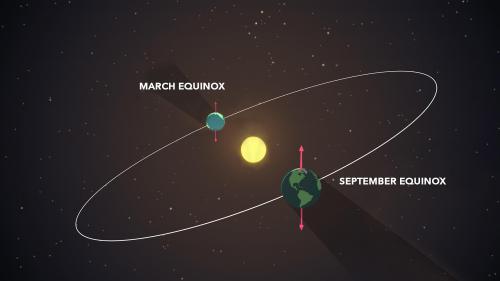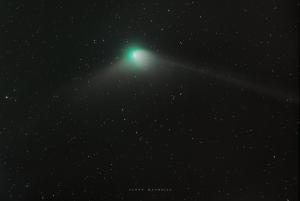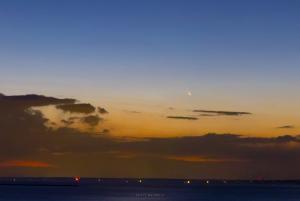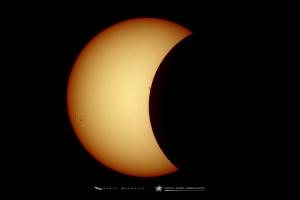Celebration of Space - September 15, 2023
On Saturday, September 23, 2023 at 2:50 am ET, Earth will reach the point in its orbit where we are neither tilted towards or away from the Sun. This is called the Autumnal Equinox, and hails the start of the fall season in the Northern Hemisphere. On the Equinox, those who live along Earth’s equator will experience the Sun rising due east, passing directly overhead (zenith) at noon, and setting due west, allowing for nearly equal duration of day and night times worldwide. Since we are neither tilted towards or away from the Sun, sunrise and sunset times will be the same for corresponding locations in the Northern and Southern hemispheres. The Autumnal Equinox also signals a shift in day and night duration to the part of the year with longer nights than days in the Northern Hemisphere. All that aside, this celestial happening calls in the autumn season in the Northern Hemisphere and with it comes beautiful fall colors, harvest festivals, Oktoberfest, pumpkin pie, spooky décor, maniacal leaf-peeping, lunar halos, the Andromeda Galaxy, and the inevitable dive into shorter days with cooler temps, and in 2023—the start of a fabulous season of planetary observations with Jupiter and Saturn both visible in the night sky. So step out on the morning of the 23rd and welcome the start of the autumn season and all the amazing trappings that come with it.
Comet C/2023 P1 Nishimura has been all the rage of late. It is a long period comet (greater than 200 year orbit) that was somewhat of a surprise being that it was only recently discovered. Comet P1 may be a new comet as well, meaning that this transit may be its first time visiting the inner Solar System. Over the past week, the comet has begun closing in on its perihelion passing, which is when it will make its closest approach to the Sun, and it will be a close perihelion compared to many of the comets we have seen over the past several years. Perihelion will occur on Monday, September 18, 2023, and the comet has been evolving spectacularly over the past week. The current magnitude of the comet is 3.2, which is well into naked eye visibility, and the comet has grown a tail that is over 7º long! Of course, the last week has been completely overcast in Southern New England, so we’ve been missing out on a view. Now that the comet is approaching perihelion, it may become visible in the evening sky starting this weekend, just after sunset.
Now it should be noted that even though magnitude 3.2 is well within naked eye visibility, the comet has been embedded in the light of predawn, which will make it difficult to see with the naked eye. Even during perihelion and the days after, the comet will be buried in the light of dusk after sunset. The hope is that the comet survives its perihelion transit, as it is closer than usual, and then becomes incredibly bright from the outgassing events during perihelion. This can make the comet bright enough to see with the naked eye in the evening dusk sky.
Observing the comet will be a challenge as it is very close to the Sun. Observers will need to find a location with a very low view of the west horizon. Being in Rhode Island, this is quite easy. Some notable locations are Prospect Park in Providence, Point Judith, Brenton Point in Newport, Beavertail, and Watch Hill, just to mention a few. Be there for sunset, and be ready with binoculars or possibly a small wide field telescope. Once the Sun sets and dusk begins to set in, start scanning the western sky within 10º of the horizon. The comet’s coma, which is a bright atmosphere that forms around the comet’s nucleus will be the easiest to observe, with the tail potentially being visible depending on how bright it becomes. We can’t guarantee that it will be visible, but many morning sky watchers this week have had stunning views with cameras and binoculars around the world. So it is certainly worth a try. Worse case scenario, you score a beautiful late summer sunset. Here is a stunning capture of Comet Nishimura over Slovakia. Happy comet hunting!
Yesterday, Thursday, September 14, 2023, marked the one month marker till the next Solar Eclipse that will occur over our region. On Saturday, October 14, 2023, an annular solar eclipse will occur over the United States, with Southern New England experiencing a 19% partial eclipse. If the weather is favorable, this will be a fantastic autumn day under the Sun. At Frosty Drew Observatory and Science Center we will be hosting an event for the eclipse. The event starts at 10:00 am and goes until 3:00 pm, and will have solar telescopes, solar projectors, eclipse viewers, and live views of the eclipse. Ticket sales have opened and each ticket comes with a pair of Eclipse Glasses for safe viewing of the Sun. Visit our event page to learn more about the day.
Among leadership in Charlestown, there appears to be a belief that a majority of Charlestown residents want Ninigret Park to be lighted, therefore removing Ninigret Park from the list of known dark sky sites in the U.S. At Frosty Drew we meet and service hundreds of Charlestown residents that love the beauty of the night sky and are thrilled that their town is considered the most accessible spot in New England to see the Milky Way. Additionally, the wildlife that comes out at night in Ninigret Park is astounding, which is directly related to efforts that Charlestown has done to preserve the night. At meetings of Town leadership, the term “dark sky compliant” has been promoted as a means to light any area without repercussion to the night sky. I challenge anyone who believes this to visit Garden City in Cranston, RI. All parking lot lighting in Garden City Center is dark sky compliant. Dark sky compliant lighting is what one would install in a region where a dark site exists and/or where the community or individual wants to minimize their contribution to light pollution, climate change, and the loss of the night. Another important characteristic of dark sky compliant lighting is that it is installed in a manner that brings the minimum amount of light required, not maximum. Installing high output dark sky compliant lights in Ninigret Park will absolutely impact a person’s view of the Milky Way and the thousands of stars that are visible overhead. A view that thousands of visitors, and residents enjoy today, as well as the survival of nocturnal wildlife. If you are a resident of Charlestown Rhode Island, and do not want lights in Ninigret Park, you should know that a vast majority of your leadership wants to light Ninigret Park.
- Author:
- Scott MacNeill
- Entry Date:
- Sep 15, 2023
- Published Under:
- Scott MacNeill's Columns






